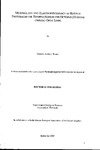MORPHOLOGY AND ELECTROPHYSIOLOGY OF RETINAL PHOTORECEPTOR TERMINATIONS IN THE OCTOPUS (ELEDONE CIRROSA) OPTIC LOBE
| dc.contributor.author | Hussey, Dominic Anthony | |
| dc.contributor.other | School of Biological and Marine Sciences | en_US |
| dc.date.accessioned | 2013-10-23T11:35:55Z | |
| dc.date.available | 2013-10-23T11:35:55Z | |
| dc.date.issued | 1999 | |
| dc.identifier | NOT AVAILABLE | en_US |
| dc.identifier.uri | http://hdl.handle.net/10026.1/2323 | |
| dc.description.abstract |
Cephalopods possess a well-developed visual system encompassing a pair of camera-type eyes attached to specific visual processing regions of the central nervous system known as the optic lobes. The retina contains a single type of photoreceptive cell, which send axons via a dorso-ventral chiasma to the optic lobes. Although electrophysiological recordings have been routinely obtained from the retina there are few recordings from the optic lobe. This study investigated the morphology and electrophysiology of the first synapse in the Octopus (Eledone cirrosa) visual system. The morphology and innervation patterns of individual optic nerves onto the optic lobe were revealed using the carbocyanine dye, Oil. Optic nerves had characteristic mapping patterns depending upon where they entered the optic lobe. Nerves innervating central regions of the optic lobe spread laterally in both directions for equal distances. Optic nerves that entered the lobe on the dorsal and ventral surfaces of the lobes spread for greater distances in only one direction. The morphology of the photoreceptor terminations in the cortex were comparable to the morphologies revealed in previous studies. A brain slice preparation of the octopus optic lobe was developed in order to make the first in vitro electrophysiological recordings from the first synapse in the visual pathway. Extracellular pre- and postsynaptic responses were recorded from the optic lobe and these were characterised. Using a variety of techniques (paired-pulse tests, frequency inhibition, ionic substitution) the different evoked field potentials recorded from different layers of the optic lobe slice were separated into pre- and postsynaptic components. Postsynaptic responses obtained in the outer regions of the plexiform zone were polysynaptic and negative in inflection whilst those obtained from the inner granular cell layer and medulla were positive. The effects of altering the extracellular concentrations of Ca2+, Mg2+ and K+ were all investigated. The resultant electrical activity after orthodromic stimulation of a single optic nerve was mapped in the optic lobe slice and plots of lines of isopotential produced. Pharmacological studies using the in vitro slice preparation in conjunction with specific antagonists to vertebrate receptors were employed to reveal the identity of the neurotransmitter released from the retinal photoreceptor terminations. The abolishment of postsynaptic responses with alpha-bungarotoxin and the increase with the acetylcholinesterase inhibitor (eserine) indicated that the transmitter released is acetylcholine. Histochemical and immunohistochemical localisations of putative neurotransmitters (or their synthetic enzymes) in the cephalopod optic lobe were attempted. No neurotransmitter-like immunoreactivity was seen in the optic lobe, this was probably due to the primary antibodies used not recognising antigens in the tissue. In the decapod squid, Alloteuthis subulata and Loligo forbesii, AChE histochemistry revealed precise anatomical localisation of this enzyme which concurred with previous studies on other decapod species. This study has enhanced the understanding of the cephalopod visual system by providing a preparation of the optic lobe from which electrophysiological recordings can repeatabley be obtained. This preparation has been used to provide information about how visual information is passed from the retina to the central nervous system. | en_US |
| dc.description.sponsorship | Marine Biological Association of the United Kingdom | en_US |
| dc.language.iso | en | en_US |
| dc.publisher | University of Plymouth | en_US |
| dc.title | MORPHOLOGY AND ELECTROPHYSIOLOGY OF RETINAL PHOTORECEPTOR TERMINATIONS IN THE OCTOPUS (ELEDONE CIRROSA) OPTIC LOBE | en_US |
| dc.type | Thesis | |
| dc.identifier.doi | http://dx.doi.org/10.24382/4434 | |
| dc.identifier.doi | http://dx.doi.org/10.24382/4434 |
Files in this item
This item appears in the following Collection(s)
-
01 Research Theses Main Collection
Research Theses Main


